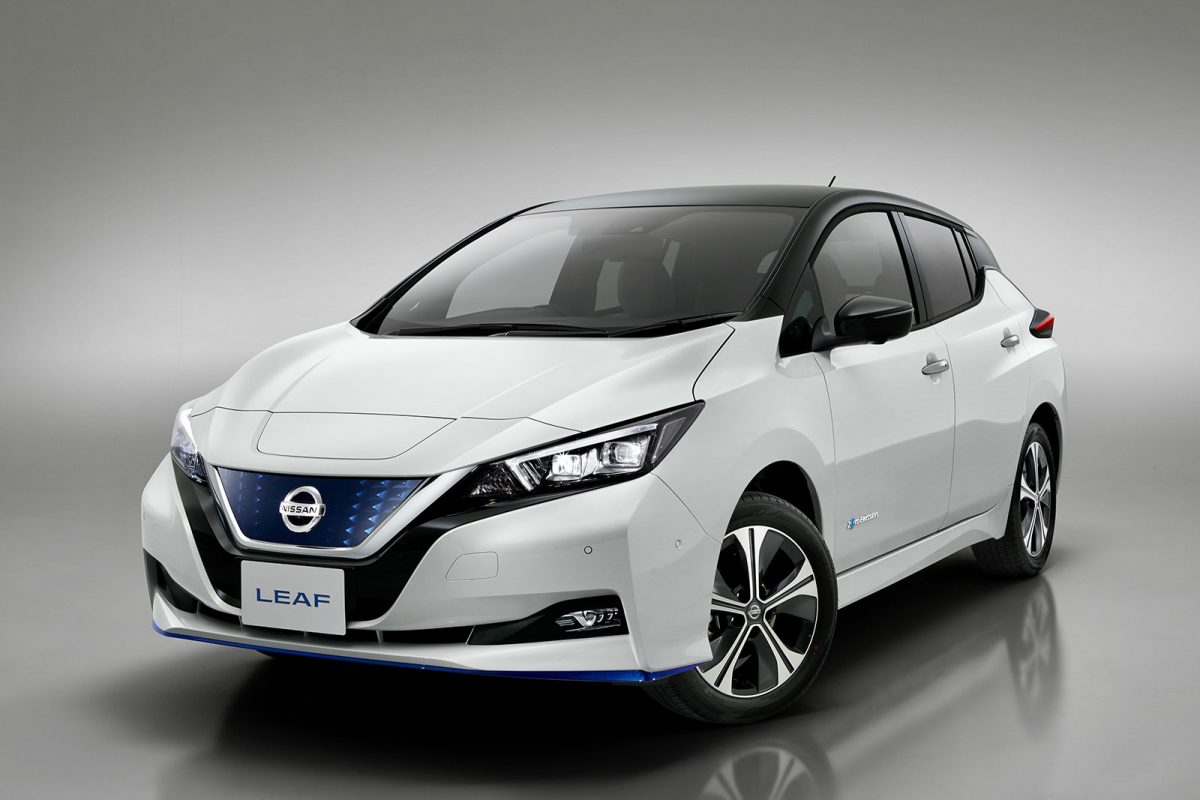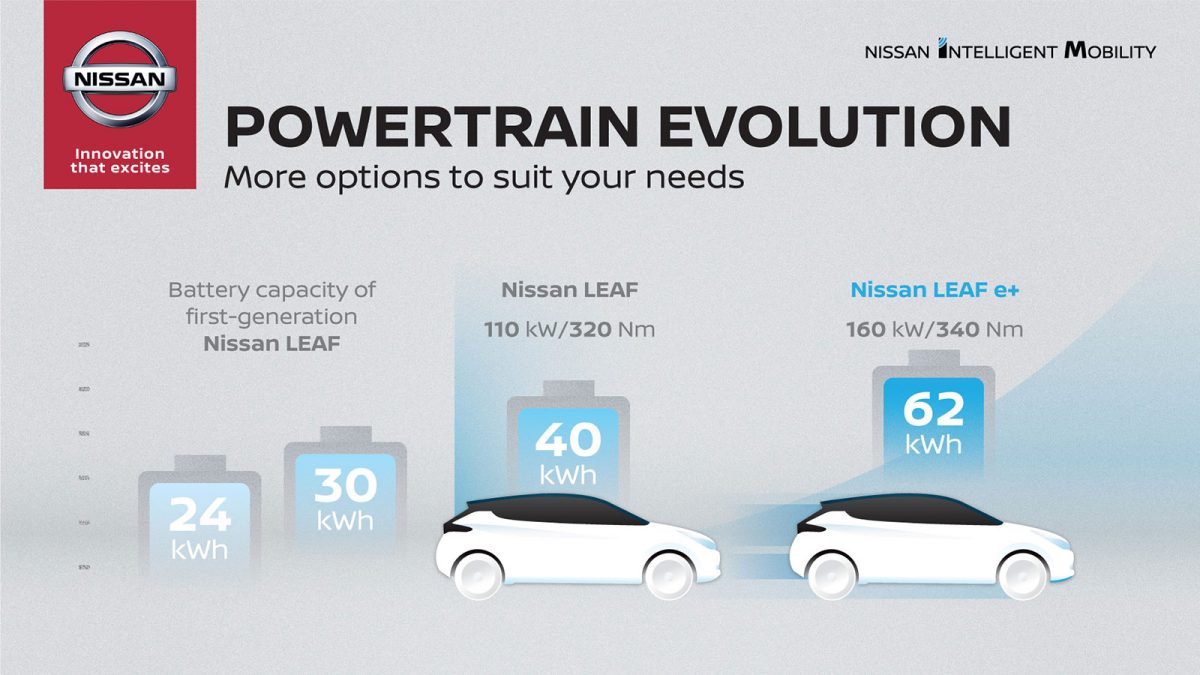Nissan LEAF e+ announced with new powertrain giving additional power and a longer 458km range

Nissan today unveiled the Nissan LEAF e+, further broadening the appeal of the world’s best-selling electric car¹ by offering a new powertrain with additional power and range. The “e+” refers to the increased energy density of the model’s battery pack and the higher output of its powertrain. The new powertrain adds to the car’s range by approximately 40 per cent, ensuring that there’s a Nissan LEAF to meet the driving needs of a wider range of customers.
“The LEAF e+ is ‘more’ LEAF, offering customers more choice in terms of power and range,” said Daniele Schillaci, executive vice president of Nissan. “By offering customers a choice of powertrains to suit their needs, the award-winning Nissan LEAF is now more convenient and appealing than ever.”

More than 380,000 Nissan LEAF vehicles have been sold globally since the 100 per cent electric model first went on sale in 2010. Equipped with advanced technologies including the ProPILOT² semi-autonomous driving system and e-Pedal mode for one-pedal driving, the Nissan LEAF embodies Nissan Intelligent Mobility, the company’s vision for changing how cars are powered, driven and integrated into society. Having pioneered mass-market electric cars with the Nissan LEAF, Nissan is continuing to promote alternative vehicle transportation.
The Nissan LEAF plays a vital role in Nissan’s efforts to integrate electric vehicles and energy systems into customers’ lives – creating an “EV ecosystem.” Among these efforts is Nissan Energy, the company’s initiative for its electric vehicles to easily connect with energy systems to charge their batteries, power homes and businesses, or feed energy back to power grids, as well as new efforts to reuse batteries³. The Nissan LEAF e+ is scheduled to join the Nissan LEAF at Nissan dealerships in Japan in late January 2019. U.S. sales are expected to begin in the spring of 2019, and European sales will commence in mid-2019.

Nissan Intelligent Mobility
The Nissan LEAF e+ represents a step forward in each of the three key areas of Nissan Intelligent Mobility: Intelligent Power, Intelligent Driving and Intelligent Integration.

Nissan Intelligent Power: increased range and performance
The Nissan LEAF e+ features a new version of the Nissan LEAF’s revolutionary electric powertrain, delivering excellent energy efficiency and robust torque and power output. While the Nissan LEAF meets the needs of many customers with its driving range of up to 322 km (estimated WLTC Japan cycle)⁴, near-silent operation and smooth and responsive acceleration, the Nissan LEAF e+ offers more than 40 per cent additional range of up to 458 km (WLTC Japan cycle), allowing customers the ability to do more between charges⁵.
The high-capacity battery and more powerful motor in the LEAF e+ combine to produce 160kW of power and 340Nm of torque, enabling faster acceleration when driving at high speeds. Accelerating from 80km/h to 120km/h is nearly 13 per cent quicker. This allows the LEAF e+ to confidently pass slower-moving vehicles, exit corners faster and more seamlessly and merge easily with fast-moving traffic. The top speed has increased by approximately 10 per cent for comfortable cruising. Thanks to an available new 70kW (100kW peak) Quick Charging system, the 2019 Nissan LEAF e+ can charge more efficiently than ever⁵.
Based on early testing, Nissan LEAF e+ owners can expect similar charging times when hooked up to a 100kW charger as current Nissan LEAF owners do with a 50kW charger, despite a 55 per cent larger battery storage capacity. Even with a 25 per cent increase in energy density and the increase in energy storage capacity, the Nissan LEAF e+ battery pack is almost the same size and configuration as the pack in the Nissan LEAF. Other than a 5mm increase in overall height (16-inch wheels), the car’s exterior and interior dimensions are unchanged. Because ownership satisfaction and peace of mind are pivotal for all Nissan LEAF owners, the battery limited warranty of 8 years/160,000 km (whichever occurs first) is standard for all versions.
“The Nissan LEAF caters to 99 per cent of the expected electric vehicle buyers in the marketplace,” Schillaci said.“Between the two powertrains and available technologies and features, Nissan LEAF customers can choose their best option to accommodate their lifestyle.”
Credit: Nissan Motor Co, Ltd
¹ Based on cumulative sales data from December 2010 to December 2018.
² Called ProPILOT Assist in the U.S.
³ Availability of features and components vary by geographic region.
⁴ 400 kilometres is based on the Japanese JC08 standard, 322km is WLTC Japan cycle standard. MY18 EPA range is 150 miles. The driving range figure is obtained under specific test conditions. Actual range will vary with trim levels, options and driving conditions; see Customer Disclosure Form for details.
⁵ Estimated range 458km WLTC Japan cycle / 570km JC08 / up to 226miles EPA estimated /385km (WLTP combined range) estimated for Europe; actual range will vary with trim levels, options and driving conditions; see Customer Disclosure Form for details. Charging capacity may vary based on battery temperature.
⁶ Those who prefer conventional driving can still make full use of both the accelerator and brake pedals.
⁷ The new navigation system for the European market can also have its software and maps updated via Inter vehicle communication (IVC) systems.
⁸ These new features are available on North America and EU models only.
